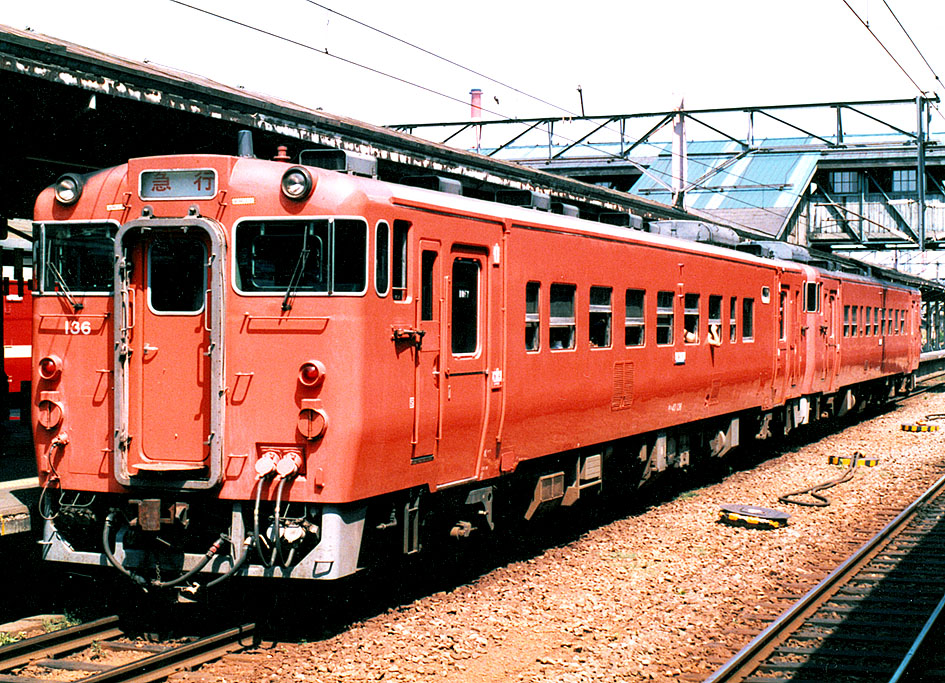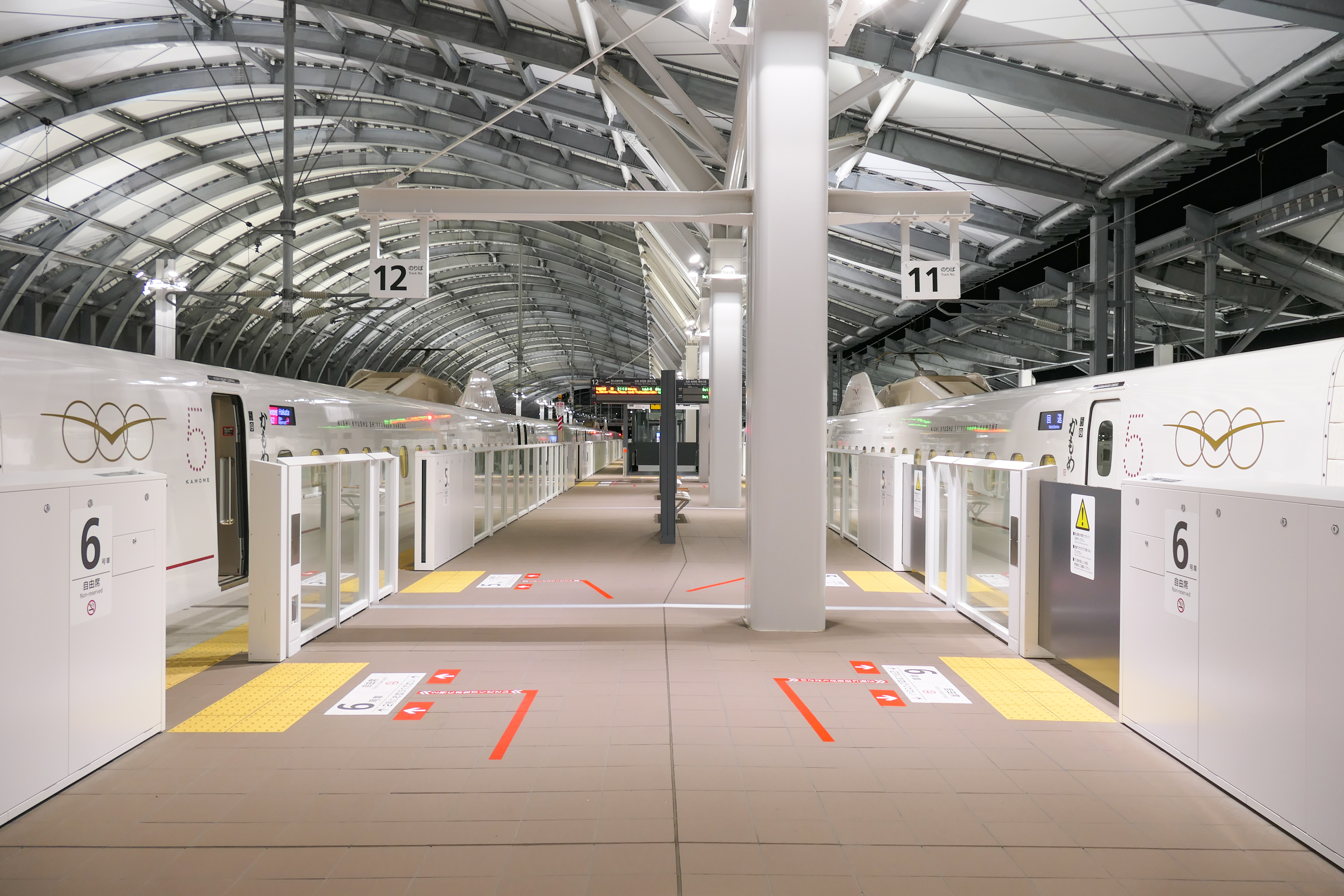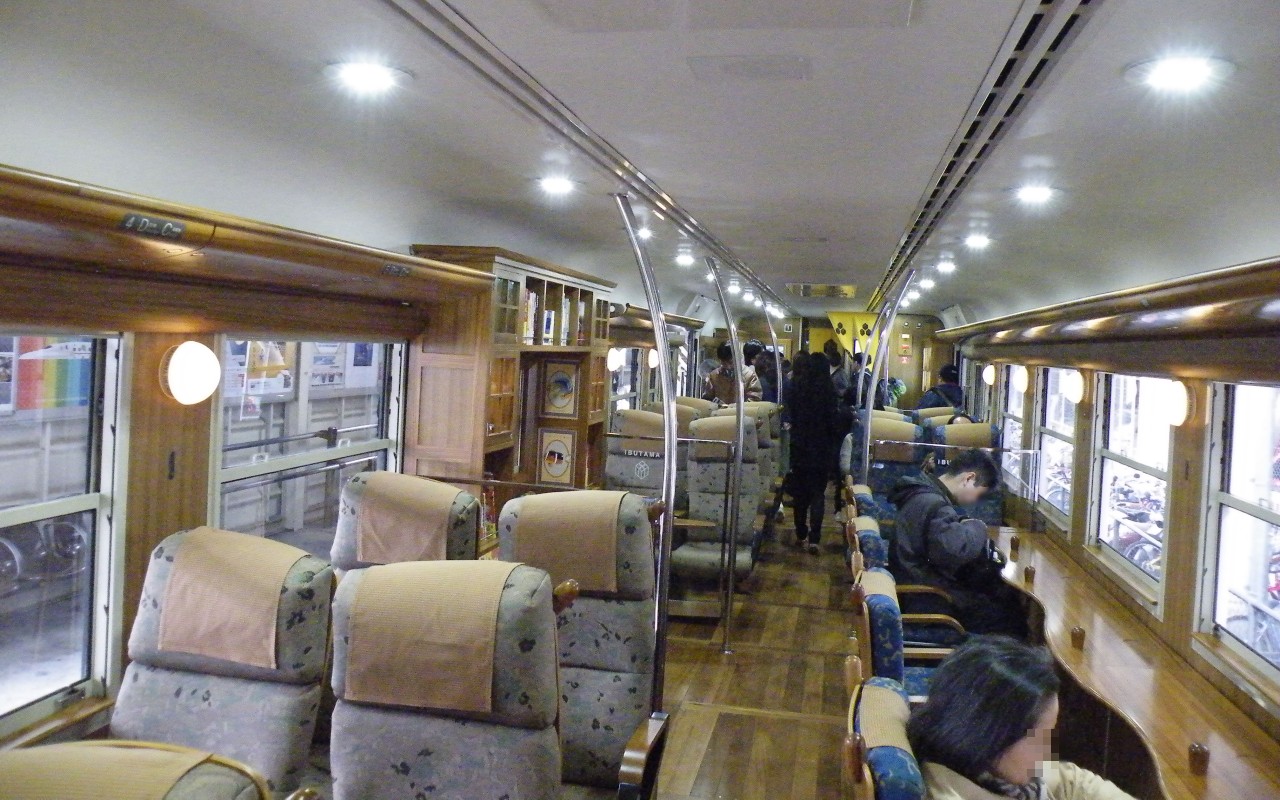|
Hayato No Kaze
The ''Hayato no Kaze'' () was a limited express service in Japan which ran between Kagoshima-Chūō Station and Yoshimatsu Station via the Kagoshima Main Line, Nippō Main Line, and Hisatsu Line. It was operated by Kyushu Railway Company (JR Kyushu). Its final run was on 21 March 2022. Schedule There were two return services per day. All trains stopped at both Osumi-Yokogawa and Kareigawa Stations for about 5 minutes. Some trains stopped at Ryugamizu Station for about 4 minutes for a view of Sakurajima. (Passengers could not alight Ryugamizu Station.) Rolling stock The train was formed of two specially converted diesel multiple unit (DMU) cars, KiHa 147-1045 and KiHa 47-8092. Initially, the train consisted of KiHa 147-1045 as reserved seating car 1 and KiHa 140-2066 as non-reserved seating car 2. From January 2006, a third car, KiHa 47-8092, was converted for use as reserved seating car 1, with KiHa 147-1045 as non-reserved seating car 2. KiHa 140-2066 was used as a spare ca ... [...More Info...] [...Related Items...] OR: [Wikipedia] [Google] [Baidu] |
Limited Express
A limited express is a type of express train or express bus service that stops at fewer locations compared to other express services on the same or similar routes. Japan The term "limited express" is a common translation of the Japanese compound noun ; ; often abbreviated as , though some operators translate the word differently. There are two types of limited express trains: inter-city rail, intercity, and commuter rail, commuter. The former type of limited express trains generally use long-distance coaches, equipped better than other ordinary express trains, including reserved seating, dining cars, food and beverage cars, and "green cars" (first class cars). The latter type of limited express train usually incurs no surcharge, but seating is usually first-come, first-served, since this type of train uses commuter train coaches. Both types of trains travel faster and stop at fewer stations. Until 1972, the ''Hikari (train), Hikari'' on the Tōkaidō Shinkansen was offic ... [...More Info...] [...Related Items...] OR: [Wikipedia] [Google] [Baidu] |
Diesel Multiple Unit
A diesel multiple unit or DMU is a multiple-unit train powered by on-board diesel engines. A DMU requires no separate locomotive, as the engines are incorporated into one or more of the carriages. Diesel-powered single-unit railcars are also generally classed as DMUs. Diesel-powered units may be further classified by their transmission type: diesel–mechanical DMMU, diesel–hydraulic DHMU, or diesel–electric DEMU. Design The diesel engine may be located above the frame in an engine bay or under the floor. Driving controls can be at both ends, on one end, or in a separate car. Types by transmission DMUs are usually classified by the method of transmitting motive power to their wheels. Diesel–mechanical In a diesel–mechanical multiple unit (DMMU), the rotating energy of the engine is transmitted via a Transmission (mechanics), gearbox and driveshaft directly to the wheels of the train, like a automobile, car. The transmissions can be shifted manually by the driver, a ... [...More Info...] [...Related Items...] OR: [Wikipedia] [Google] [Baidu] |
Railway Services Discontinued In 2022
Rail transport (also known as train transport) is a means of transport using wheeled vehicles running in tracks, which usually consist of two parallel steel rails. Rail transport is one of the two primary means of land transport, next to road transport. It is used for about 8% of passenger and freight transport globally, thanks to its energy efficiency and potentially high speed.Rolling stock on rails generally encounters lower frictional resistance than rubber-tyred road vehicles, allowing rail cars to be coupled into longer trains. Power is usually provided by diesel or electric locomotives. While railway transport is capital-intensive and less flexible than road transport, it can carry heavy loads of passengers and cargo with greater energy efficiency and safety. Precursors of railways driven by human or animal power have existed since antiquity, but modern rail transport began with the invention of the steam locomotive in the United Kingdom at the beginning of the 19th c ... [...More Info...] [...Related Items...] OR: [Wikipedia] [Google] [Baidu] |
2004 Establishments In Japan
4 (four) is a number, numeral and digit. It is the natural number following 3 and preceding 5. It is a square number, the smallest semiprime and composite number, and is considered unlucky in many East Asian cultures. Evolution of the Hindu-Arabic digit Brahmic numerals represented 1, 2, and 3 with as many lines. 4 was simplified by joining its four lines into a cross that looks like the modern plus sign. The Shunga would add a horizontal line on top of the digit, and the Kshatrapa and Pallava evolved the digit to a point where the speed of writing was a secondary concern. The Arabs' 4 still had the early concept of the cross, but for the sake of efficiency, was made in one stroke by connecting the "western" end to the "northern" end; the "eastern" end was finished off with a curve. The Europeans dropped the finishing curve and gradually made the digit less cursive, ending up with a digit very close to the original Brahmin cross. While the shape of the character ... [...More Info...] [...Related Items...] OR: [Wikipedia] [Google] [Baidu] |
Railway Services Introduced In 2004
Rail transport (also known as train transport) is a means of transport using wheeled vehicles running in tracks, which usually consist of two parallel steel rails. Rail transport is one of the two primary means of land transport, next to road transport. It is used for about 8% of passenger and freight transport globally, thanks to its energy efficiency and potentially high speed.Rolling stock on rails generally encounters lower frictional resistance than rubber-tyred road vehicles, allowing rail cars to be coupled into longer trains. Power is usually provided by diesel or electric locomotives. While railway transport is capital-intensive and less flexible than road transport, it can carry heavy loads of passengers and cargo with greater energy efficiency and safety. Precursors of railways driven by human or animal power have existed since antiquity, but modern rail transport began with the invention of the steam locomotive in the United Kingdom at the beginning of the 19th ... [...More Info...] [...Related Items...] OR: [Wikipedia] [Google] [Baidu] |
Named Passenger Trains Of Japan
Named may refer to something that has been given a name. Named may also refer to: * named (computing), a widely used DNS server * Naming (parliamentary procedure) * The Named (band), an American industrial metal group In literature: * ''The Named'', a fantasy novel by Marianne Curley * The Named, a fictional race of prehistoric big cats, depicted in ''The Books of the Named'' series by Clare Bell See also * Name (other) * Names (other) Names are words or terms used for identification. Names may also refer to: * ''Names'' (EP), by Johnny Foreigner * ''Names'' (journal), an academic journal of onomastics * The Names (band), a Belgian post-punk band * ''The Names'' (novel), b ... * Naming (other) {{disambiguation ... [...More Info...] [...Related Items...] OR: [Wikipedia] [Google] [Baidu] |
Joyful Train
is the name given to railway rolling stock or train sets operated by the JR Group in Japan primarily for charters, special events, tourist excursions, and other similar purposes. Traditionally, this term is only used for chartered trains dedicated to large group travel, but in recent years, it has expanded to include sightseeing trains and tourist trains as well, often called in Japanese, and their distinctions are made ambiguous. This page includes all trains considered "Joyful trains" and "Sightseeing trains". History Origins The "Joyful Train" concept can be traced back to 1960, when a 1935-vintage SuHaShi 29 dining car was converted into a Japanese-style ''o-zashiki'' train with ''tatami'' flooring and ''shoji'' paper screens on the windows. This could be coupled to regular service trains for use by charter parties. A second car was similarly modified in April 1961. The first train to directly be called "Joyful Train" was the ''Salon Express Tokyo'', a European styled train ... [...More Info...] [...Related Items...] OR: [Wikipedia] [Google] [Baidu] |
Nagasaki Station
is a railway station in Nagasaki, Nagasaki Prefecture, Japan, operated by the Kyushu Railway Company (JR Kyushu). It is the terminus of the Nishi Kyushu Shinkansen and the Nagasaki Main Line, as well as the westernmost high-speed Shinkansen railway station in Japan. The station is connected by the ''Kamome'' Shinkansen service and the ''Relay Kamome'' limited express to Hakata, and by the ''Seaside Liner'' rapid service to Sasebo. Nagasaki Electric Tramway services call at a stop in front of the station. Lines * Nishi Kyushu Shinkansen * Nagasaki Main Line Station layout The conventional line station has two elevated island platforms serving five tracks. The Shinkansen station has two island platforms serving four tracks. Platforms History The station was opened on 5 April 1905 when the railway was extended from the former Nagasaki Station to the present station. The former station, opened in 1897, was renamed Urakami Station. *5 April 1905 - Opened by Kyushu Railway. * ... [...More Info...] [...Related Items...] OR: [Wikipedia] [Google] [Baidu] |
Takeo-Onsen Station
is a railway station operated by Kyushu Railway Company (JR Kyushu) in Takeo, Saga, Japan. It is operated by JR Kyushu and is served by the Nishi Kyushu Shinkansen and the Sasebo Line. Lines The station is served by the Sasebo Line and is located 13.7 km from the starting point of the line at . Besides the local services on the Sasebo Line, the JR Kyushu Limited Express services ''Midori'' (from to ) and ''Huis Ten Bosch'' (from to ) also stop at this station. The Nishi Kyushu Shinkansen to and from also terminates here. Services to and from are additionally provided with the Limited Express ''Relay Kamome'' service, with a cross-platform transfer for Nishi Kyushu Shinkansen passengers. Station layout The station building consists of two side platforms serving two elevated tracks. The station complex has entrances north and south of the tracks and is a modern structure completed in 2009. The Nishi Kyushu Shinkansen has an island platform and a side platform serving th ... [...More Info...] [...Related Items...] OR: [Wikipedia] [Google] [Baidu] |
Two Stars 4047
2 (two) is a number, numeral and digit. It is the natural number following 1 and preceding 3. It is the smallest and the only even prime number. Because it forms the basis of a duality, it has religious and spiritual significance in many cultures. Mathematics The number 2 is the second natural number after 1. Each natural number, including 2, is constructed by succession, that is, by adding 1 to the previous natural number. 2 is the smallest and the only even prime number, and the first Ramanujan prime. It is also the first superior highly composite number, and the first colossally abundant number. An integer is determined to be even if it is divisible by two. When written in base 10, all multiples of 2 will end in 0, 2, 4, 6, or 8; more generally, in any even base, even numbers will end with an even digit. A digon is a polygon with two sides (or edges) and two vertices. Two distinct points in a plane are always sufficient to define a unique line in a nontrivial ... [...More Info...] [...Related Items...] OR: [Wikipedia] [Google] [Baidu] |
Kyushu Shinkansen
The is a Japanese Shinkansen high-speed railway network. It is an extension of the San'yō Shinkansen from Honshu connecting the city of Fukuoka (Hakata Station) in the north of Japan's Kyushu Island to the city of Kagoshima (Kagoshima-Chuo Station) in the south. The line runs parallel to the existing Kagoshima Main Line and is operated by Kyushu Railway Company (JR Kyushu). The southernmost section of the track was constructed first, opening on 13 March 2004. The dual-track offered a significant improvement in transit time over the equivalent single-track section of the Kagoshima Main Line, despite the need for passengers to change to a ''Relay Tsubame'' narrow gauge train at Shin-Yatsushiro, and the remainder of the journey to Hakata Station. The northernmost section opened on 12 March 2011, enabling through-services to Shin-Osaka (and with an interchange, to Tokyo). However, opening ceremonies were cancelled due to the 2011 Tōhoku earthquake and tsunami. The Nishi Kyushu ... [...More Info...] [...Related Items...] OR: [Wikipedia] [Google] [Baidu] |
Ibusuki No Tamatebako
The is a limited express service operated by Kyushu Railway Company (JR Kyushu) in Japan since March 2011. It operates between Kagoshima-Chūō Station and Ibusuki Station via the Ibusuki Makurazaki Line. Service pattern There are three return services per day. All trains stop at Kiire. Rolling stock The train was originally formed of two specially modified KiHa 47 diesel multiple unit cars, KiHa 47-8060 and KiHa 47-9079 (formerly KiHa 47-1079), based at Kagoshima Depot. The two cars were converted at JR Kyushu's Kokura Works. A third car, KiHa 140-2066, formerly used in the '' Hayato no Kaze'' DMU set, was rebuilt in 2012 to ''Ibusuki no Tamatebako'' style, entering service from 24 March 2012. File:JRK DC Kiha47-8060.jpg, Car 1: KiHa 47-8060 File:JRK DC Kiha47-9079.jpg, Car 2: KiHa 47-9079 File:JRK DC Kiha140 2066.jpg, Car 3: KiHa 140-2066 Exterior The train is painted black on the landward side, and white on the seaward side, with gold lining and lettering. Interio ... [...More Info...] [...Related Items...] OR: [Wikipedia] [Google] [Baidu] |






